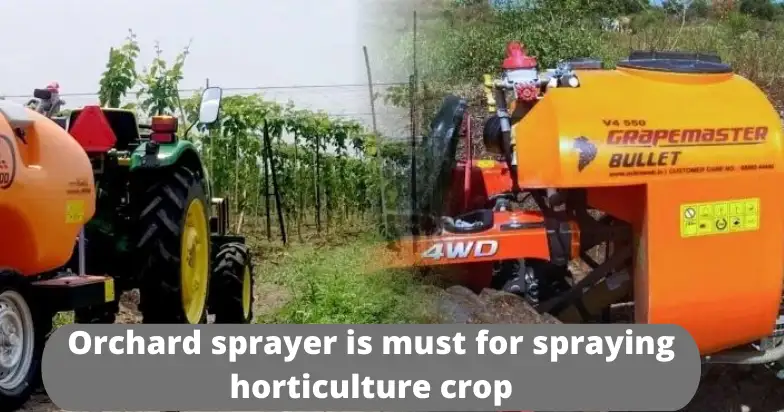Orchard sprayers are more efficient than sprayers in target areas, time, labor, etc. They spray fertilizers, herbicides, crop production ingredients, and pest maintenance agents as airborne liquids. This sprayer’s fluid and air delivery systems may be adjusted to suit different orchard circumstances. Spray gun and nozzle apply this liquid. Orchards are planted to produce food. Orchards cultivate fruit or nuts commercially. Extensive gardens are occasionally employed for aesthetic and productive purposes in orchards.
Orchard pest management effectiveness and profitability depend on spray operators’ abilities to analyze orchard conditions and adjust sprayer machine setup and operating tactics to maximize sprayer performance. Combining working capabilities, equipment performance, synchronization, and the chemical selection improves results.
Mitra is India’s best agriculture sprayer machine producer. Our orchard sprayers target tree canopy and hard-to-reach locations. The spraying procedure is precise.
Specifications of Orchard Sprayer
- Mating Power: 11 kW(15 hp)
- Chemical Tank: 600 L
- Spray Range: 10 m
- Nozzles: 10
- Pump Flow Rate: 54 L/min
- Working Pressure: 0-4 MPa
- Ventilation Fan Dia: 600 mm
- Hand Wash Tank: 10 L
- Net Weight: 300 kg
Locomotion Methods
Most pull-type sprayers are driven by a tractor’s PTO shaft or a specialized engine. Pull-type sprayers are cheaper but harder to use. Some feature multi-jointed shafts for enhanced turn tracking. Depending on age and condition, pulling-type sprayers can cost more than modern ones. Check your tractor blower PTO speed and horsepower before buying.
Last but not least, the most expensive option is a self-propelled orchard sprayer. New versions can cost considerably more than that because of their capacity, power, and other features. Some self-propelled sprayers are height-adjustable or have a high-clearance design to accommodate a range of crop heights.
Tank Capacity
Most orchard and vineyard sprayers have tank capacities between 40 and 100 or 200 gallons (151 to 379 or 757 liters). The Rears Powerblast, for example, is a high-capacity type that can store up to 1,200 gallons (4,542 liters) of water for use on a large plot of land.
Flow Rate
Flow rate, in gallons per minute, is another sprayer concern. Depending on their distribution radius and capacity, the sprayers above range from 2 to 22.5 gpm (7.6 to 85.2 l/min). Rears Powerblast Tower for massive projects can pump 80 gpm (303 l/min).
Working Pressure
Most sprayers’ pumping force may be adjusted. Varying circumstances demand different spray system pressures. Thus manufacturers propose a pressure range. 60 to 260 pounds per square inch (414 to 1,793 kilopascals) is typical for sprayers with conventional nozzles. Specific truck bed systems may reach up to 725 psi (5,000 kph) for unusual purposes. High pressures wear nozzles. Thus you may require stainless steel or ceramic nozzles to save money.
Distance
Payload horizontal and vertical distance is related to operational pressure. Air blast sprayers’ axial or centrifugal fans vary in airflow. What counts to your orchard or vineyard is how far and broad the sprayer can disseminate its spray.
Consider row spacing, plant height, and if you’ll spray all sides of each tree. Most air delivery sprayers we’ve covered stretch 18 to 50 feet (5.5 to 15 meters) vertically and 20 to 55 feet (6.1 to 16.8 meters) horizontally. Some mist devices may reach 95 feet (29 meters) vertically and 180 feet (55 meters) horizontally. Horizontal reach is somewhat greater than boom width. Pay attention to the horizontal distance a boomless model may reach by emitting the load sideways without booms. Low-mounted shrouds and precise nozzles provide consistent coverage at low volume and pressure with less wind loss.
Think About It: Sprayers for the Orchard
If you’re interested in purchasing a used orchard sprayer, it’s a good idea to check the engine hours and see how many acres it’s sprayed. Check the disc and core of each nozzle for signs of wear. Look for corrosion or leaks in the hoses, tanks, tires, plastic and rubber components, and pump. Determine when and what components were last replaced. Having proper service documentation is usually recommended. Just ask to see the sprayer in action or have it run with some water. Check whether the droplet size and air supply speed are changeable separately and how simple or complex the process is.
Finally, remember that most of the guidance provided in this page’s main article also applies to nearly new sprayers.

